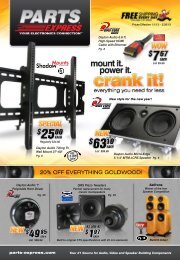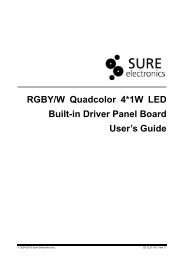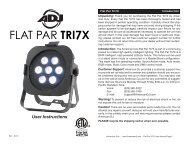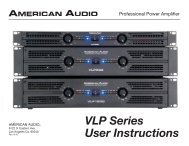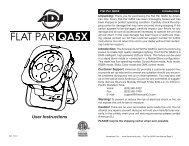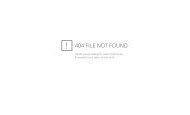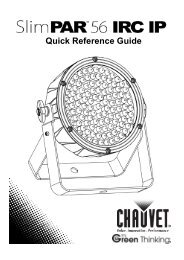Our Sales Flyer (PDF) - Parts Express
Our Sales Flyer (PDF) - Parts Express
Our Sales Flyer (PDF) - Parts Express
You also want an ePaper? Increase the reach of your titles
YUMPU automatically turns print PDFs into web optimized ePapers that Google loves.
Speaker Building<br />
D I Y<br />
ourself<br />
Double Trouble<br />
Matt Phillips is back to show us what a pair of<br />
Dayton Audio Ultimax 10” subwoofers can do<br />
in the right hands. The Double Troubles are an<br />
experiment in excess, and proof that there’s never<br />
too much of a good thing!<br />
1<br />
Design Goals<br />
These new subwoofers would have to outperform<br />
every other one I have owned prior to today, which<br />
includes anything from a wide variety of car subs<br />
years ago, to my present TC Sounds Epic 8"<br />
ported subwoofers. I wanted to stick with a sealed<br />
design this time in order to improve the music<br />
playback capabilities of my system, as well. I<br />
also intended to make the strongest and heaviest<br />
enclosures I could, so I would not compromise<br />
anything or have regrets later.<br />
2<br />
back view<br />
Driver Selection<br />
If you have followed any of my other projects, then you know I like<br />
to get a lot from a little. So, when Dayton Audio brought in the new<br />
Ultimax subwoofers, they piqued my interest immediately. I modeled a<br />
few different designs and decided the 10" would be perfect (of course)<br />
–after all, I would be using two of them. The Ultimax subwoofers<br />
are incredibly overbuilt, have the stiffest cone assemblies I’ve ever<br />
encountered, possess very low-distortion motor structures, and their<br />
high-roll surrounds will make most other subwoofers in this class run<br />
home to their mommies.<br />
3<br />
Enclosure Design<br />
I like the look of my cabinets to be deep and narrow if possible, so<br />
I came up with exterior dimensions that complemented the proper<br />
internal volume. I knew I was going to use overkill bracing and I also<br />
wanted to have a sand-filled cavity to help balance out the overall<br />
weight of the enclosure. Because of this, my exterior dimensions<br />
ended up being 12-1/2" W x 17-1/2" H x 19" D, with a total internal<br />
volume of 1.043 cubic feet after driver and bracing displacement. This<br />
provided a slightly low Qtc of 0.632. The amount of bracing I used may<br />
not be necessary for most people, but I knew that I wouldn’t be happy<br />
without it. These drivers will still perform admirably when used with a<br />
1.0 cubic foot Dayton Audio enclosure.<br />
18 1-800-338-0531



